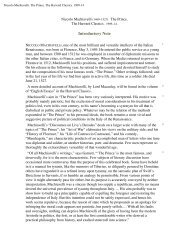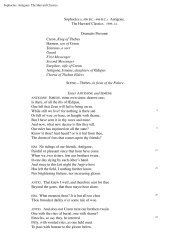Notre Dame de Paris - Bartleby.com
Notre Dame de Paris - Bartleby.com
Notre Dame de Paris - Bartleby.com
You also want an ePaper? Increase the reach of your titles
YUMPU automatically turns print PDFs into web optimized ePapers that Google loves.
the University, Rue <strong>de</strong> la Juiverie (Jewry) in the City, and Rue Saint-Martin in the Town, crossing the<br />
river twice, as the Petit-Pont and the Pont <strong>Notre</strong> <strong>Dame</strong>. The second—which was called Rue <strong>de</strong> la Harpe<br />
on the left bank, Rue <strong>de</strong> la Barillerie on the island, Rue Saint-Denis on the right bank, Pont Saint-Michel<br />
on one arm of the Seine, Pont-aux-Change on the other—ran from the Porte Saint-Michel in the<br />
University to the Porte Saint-Denis in the Town. For the rest, un<strong>de</strong>r however many names, they were still<br />
only the two streets, the two thoroughfares, the two mother-streets, the main arteries of <strong>Paris</strong>, from which<br />
all the other ducts of the triple city started, or into which they flowed.<br />
In<strong>de</strong>pen<strong>de</strong>ntly of these two principal streets, cutting diametrically through the breadth of <strong>Paris</strong> and<br />
<strong>com</strong>mon to the entire capital, the Town and the University had each its own main street running in the<br />
direction of their length, parallel to the Seine, and intersecting the two “arterial” streets at right angles.<br />
Thus, in the Town you <strong>de</strong>scen<strong>de</strong>d in a straight line from the Porte Saint-Antoine to the Porte<br />
Saint-Honoré; in the University, from the Porte Saint Victor to the Porte Saint-Germain. These two great<br />
thoroughfares, crossing the two first mentioned, formed the frame on to which was woven the knotted,<br />
tortuous network of the streets of <strong>Paris</strong>. In the inextricable tangle of this network, however, on closer<br />
inspection, two sheaf-like clusters of streets could be distinguished, one in the University, one in the<br />
Town, spreading out from the bridges to the gates. Something of the same geometrical plan still exists.<br />
Now, what aspect did this present when viewed from the top of the towers of <strong>Notre</strong> <strong>Dame</strong> in 1482?<br />
That is what we will en<strong>de</strong>avour to <strong>de</strong>scribe.<br />
To the spectator, arrived breathless on this summit, the first glance revealed only a bewil<strong>de</strong>ring jumble<br />
of roofs, chimneys, streets, bridges, squares, spires, and steeples. Everything burst upon the eye at<br />
once—the carved gable, the high, pointed roof, the turret clinging to the corner wall, the stone pyramid<br />
of the eleventh century, the slate obelisk of the fifteenth, the round, stark tower of the donjon-keep, the<br />
square and elaborately <strong>de</strong>corated tower of the church, the large, the small, the massive, the airy. The gaze<br />
was lost for long and <strong>com</strong>pletely in this maze, where there was nothing that had not its own originality,<br />
its reason, its touch of genius, its beauty; where everything breathed of art, from the humblest house with<br />
its painted and carved front, its visible timber framework, its low-browed doorway and projecting<br />
storeys, to the kingly Louvre itself, which, in those days, boasted a colonna<strong>de</strong> of towers. But here are the<br />
most important points which struck the eye when it became some-what accustomed to this throng of<br />
edifices.<br />
To begin with, the City. “The island of the City,” as Sauval observes—who, with all his pompous<br />
verbosity, sometimes hits upon these happy turns of phrase—“the island of the City is shaped like a great<br />
ship sunk into the mud and run aground lengthwise, about mid-stream of the Seine.” As we have already<br />
shown, in the fifteenth century this ship was moored to the two banks of the Seine by five bridges. This<br />
likeness to a ship had also struck the fancy of the heraldic scribes; for, according to Favyn and Pasquier,<br />
it was from this circumstance, and not from the siege by the Normans, that is <strong>de</strong>rived the ship<br />
emblazoned in the arms of <strong>Paris</strong>. To him who can <strong>de</strong>cipher it, heraldry is an algebra, a <strong>com</strong>plete<br />
language. The whole history of the later half of the Middle Ages is written in heraldry, as is that of the<br />
first half in the symbolism of the Roman churches—the hieroglyphics of feudalism succeeding those of<br />
theocracy.<br />
The City, then, first presented itself to the view, with its stern to the east and its prow to the west.<br />
Facing towards the prow there stretched an endless line of old roofs, above which rose, broad and domed,<br />
the lead-roofed transept of the Sainte-Chapelle, like an elephant with its tower, except that here the tower










